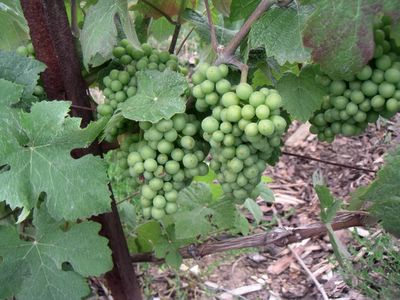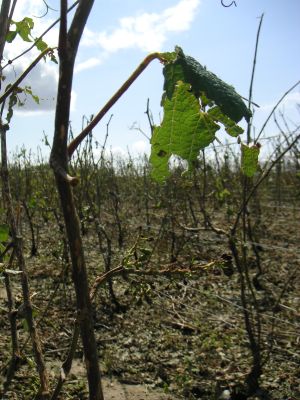 The vines after having their tops cut.
The vines after having their tops cut.The
palissage is finally through, the threads have been lifted to their final position. Our vines thus finally are ready, perfectly attached for the summer. The stems and the leaves have been separated and nicely arranged at the thread in order to make them able to catch a maximum amount of sun and enough air to hopefully avoid rot.
Reports from the plots talks about a sufficient amount of grapes that so far have a good size. Alain has been out there counting once again.
In the Montagne de Reims - as well as the heart of Côte des Blancs - it is already a couple of weeks ago that everybody seemed to be finished with their lifting. The tractors have driven through the rows to cut the top of the stems equally long ago.
Second heat of the rognageSince then the stems that were not long enough to be within the reach of the knife, has grown longer. They are the ones, that now make the plots look wild and ungovernable once again with green stems, that irregularly bristles in all directions. When they soon will have their heads chopped off, the growth in the top will stop for this season. But the vine does not give in easily, it will begin to grow on the sides instead.
Today we saw quite a few with the big scissors out to remove the
entre-coeurs which are green stems that grow on the sides - not fertile - and therefore not wanted. The most precise way to get rid of them is to walk up and down the rows to cut them off manually. We will have to find time for this task too, another half or maybe even full day of work.
 The wild growth of the vine will be limited by the palissage and the rognage.
The wild growth of the vine will be limited by the palissage and the rognage.The machine company, that performs the tractor-work in our rows, did the first
rognage last week. It should do since it is rather late. Probably all stems at this late stage have been long enough to have had their tops cut off. The vines will then have their sides trimmed regularly all summer in order to keep their summer apperance of nicely trimmed hedges. Only in August, the work will stop. This is the time when the priorities of the vine change.
The plant simply changes focus and begin to mature the grapes rather than just grow itself. The stems will change from soft, green shoots and turn into real and hard wood. This is called the
veraison. Only after this time the berries will begin to change colour.
The bottom is not cleanNobody does a piece of manual work better than he - or she - who is dependant on the result on the bottom line. It is a truth that goes for the work, that the young man, who helps us out, has done as well. Even it is "ok" according to Alain, the bottom is not clean.
This means that stems have been left at the feet of the plants, that ought to have been lifted with the others or removed completely. The risk - if they stay - is that they will collect humidity, that provides a great microclimate for all kinds of fungus, that we do not want the vines to host. Therefore they must be removed. The thing is to find an empty slot.
 After the palissage: The appearance of the vines is the same as neatly cut hedges
After the palissage: The appearance of the vines is the same as neatly cut hedgesFurthermore Alain has found an unpleasantly high amount of plants with yellow leaves in the bottom of the plot. This can be due to a lack of something, but unfortunately it can also be a sign of the disease
esca. Even we have worked quite intensively in the autumn and spring to get rid of it, it is a bit of a challenge to get completely rid of it. So far it is too early to have an opinion.
Thunderstorms follow the MarneNo matter what now the rows are trimmed and ready for the summer. Nice to know. The thunderstorms of the last weeks seem to follow the river Marne. We have not really been too badly bothered. On the contrary they have supplied enough rain to skip watering the garden now and then...
But in Épernay there were floodings some weeks ago. In Chalons-en-Champagne my sister in law some days ago sat frightened in her office - so she says anyway - because hail as big as pigeons eggs hammered down above her head. Or she is just practising her womanhood, I mean, after all she was inside not outside. But this kind of hail are so violent that they can destroy the paint of your car completely if it is left outside so you have good reason to pay some sort of respect. This morning the local paper, l'Union, talks about floodings in the western part of Reims.
That is the leftovers of the thunderstorms that has entertained us all night. The weatherforecast on tv has promised more tonight. We had a great view of last night's show since we spent a while at the railwaycrossing between the villages Avize and Oiry. The level crossing gage and the flashlights seemed to be released by the thunderstorms and not a goods train but it took us a while to take the courage to believe it. The lightnings that zigzagged over the darkened sky above the Marne and the Montagne de Reims behind it, really were as dramatic as you would normally only see them in either Donald Duck or films of the Harry Potter or Lord of the Rings-type
 The vine has its head chopped off at the rognagePå dansk
The vine has its head chopped off at the rognagePå danskCopyright: The copyright for text and photos at bobler.blogspot.com belongs to Solveig Tange. You may use my articles, photos or parts of them for non-commercial use and if I am credited as the author. Feel free to link to this site but not in your own frameset please.











